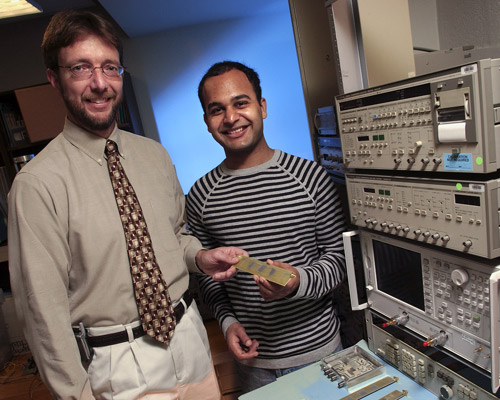After 11 years of industrial experience managing research and development of radar, antenna, and surveillance systems, William D. Jemison ’85 decided to return to campus and join the faculty.
“I enjoyed what I was doing in industry,” says Jemison, associate professor of electrical and computer engineering, “but I was attracted to Lafayette by the ability to make an impact on students, shape the early part of their careers, and help them get off on the right foot.”
Jemison specializes in microwave technology, photonics, fiber optic technology, and high-speed communication issues. “I’m primarily an experimental person. So I usually collaborate with colleagues at other institutions.” He has three active grants, including two with the National Science Foundation (NSF). The first involves finding new uses for both microwaves and fiber optic technology by combining the technologies to improve digital communication.
“For wireless communication speeds to increase, we need to use higher frequencies,” says Jemison. “We’re trying to develop the next generation of wireless communication. It’s a last-mile problem. How do we get very high-speed internet connections the last mile into homes so they can have full interactive video and wireless delivery of data?”
The second NSF project is a cooperative research and pedagogical grant to develop curricula for smart communications. “Technological change is occurring rapidly,” Jemison says. “How can we accelerate the adoption of new technology into curricula at both the undergraduate and graduate levels?”
The researchers are looking at using the web, computer design tools, and computer simulations to help accelerate new technologies into classrooms and workplaces. The goal also includes helping engineers update their skills and stay current, perhaps by involving professional societies in the distribution of a CD containing the curriculum.
The third grant is from the Office of Naval Research and involves naval applications of hybrid wireless fiber optic communication. Jemison is co-leader of this $1 million grant, which is a collaboration among seven schools and several Navy labs.
Jemison is very active in his professional society and has worked closely with many students. “My research with students is really an extension of my teaching,” says Jemison. “I like to take on students early in their careers. The students are exposed to research they would not otherwise be exposed to. It helps them understand whether grad school is right for them.”
“Bill Jemison gave me my first exposure to research, which has definitely shaped my career path since graduation,” says Ian Rippke ’00, an electrical and computer engineering graduate who did research on microwave power amplifiers and an honors thesis with Jemison. His senior year, Rippke received an NSF fellowship to pursue a doctorate in electrical engineering at Cornell University. “Working for Professor Jemison, I was doing research that only grad students were doing at other schools. He was always there to guide my work and push me to excel in my research. It really prepared me for the work I’ve done on my Ph.D. at Cornell. “
For the past four years, one of his research students has received the Microwave Theory and Techniques Society Undergraduate/Pre-Graduate Scholarship from the Institute of Electrical and Electronics Engineers.
Jemison is continuing his research while on sabbatical this year at the Center for Optical Technology at Lehigh University.

IEEE Scholarship. Prash Poddar ’04 received a Microwave Theory and Techniques Society Scholarship from Institute of Electrical and Electronics Engineers. His mentor was William Jemison ’85, associate prof. of electrical and computer engineering.
